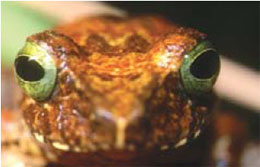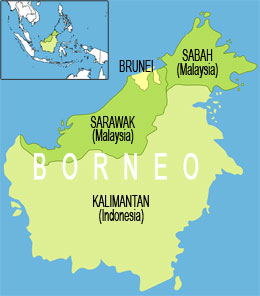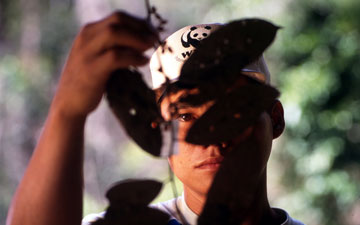52 species discovered in Borneo rainforest
52 species discovered in Borneo rainforest
mongabay.com
December 18, 2006
In 2006 scientists discovered 52 species in the highly threatened rainforests of Borneo according to a new report from WWF, an environmental group working to preserve the biodiverse “Heart of Borneo” from further destruction.
The discoveries — which include 30 fish species, two tree frog species, 16 ginger species, three tree species and one large-leafed plant species — add to the ever growing roster of previously unknown species from the island. Since June scientists have also announced the discovery of a skink species and a color-changing chameleon snake. Last year researchers spotted a mystery carnivore, while in the 1994-2004 period, scientists found some 361 previously unknown species, including 260 insects, 50 plants, 30 freshwater fish, 7 frogs, 6 lizards, 5 crabs, 2 snakes and a toad. Still little is known about most of these species, adding to the urgency of studying these rapidly disappearing forests.
  This tree frog, Polypedates chlorophthalmus, is one of the species new to science in Borneo. © Dr Indraneil Das. Map by Rhett A. Butler, mongabay.com. |
“The more we look the more we find,” said Stuart Chapman, WWF International Coordinator of the Heart of Borneo Program, an initiative that aims to conserve some 84,000 square miles (220,000 square kilometers) of mountainous rainforest in the center of the island. “These discoveries reaffirm Borneo’s position as one of the most important centers of biodiversity in the world and why conservation there is so important.”
“The remote and inaccessible forests in the Heart of Borneo are one of the world’s final frontiers for science,” said Adam Tomasek, director of WWF-US’s Borneo & Sumatra Program. “Certainly, many new species are yet to be discovered there. These forests are also vital because they are the source of most of the island’s major rivers, and provide life sustaining freshwater and other ecosystem services.”
Borneo, the third largest island in the world, was once home to some of the world’s most majestic, and forbidding forests. With swampy coastal areas fringed by mangrove forests and a mountainous interior, much of the terrain was virtually impassable and unexplored. Headhunters ruled the remote parts of the island until a century ago.
In the 1980s and 1990s Borneo underwent a remarkable transition. Its forests were leveled at a rate unparalleled in human history. Its rain forests went to industrialized countries like Japan and the United States in the form of garden furniture, paper pulp and chopsticks. Initially most of the timber was taken from the Malaysian part of the island in the northern states of Sabah and Sarawak. Later, forests in the southern part of Borneo, an area belonging to Indonesia and known as Kalimantan, became the primary source for tropical timber.
Today the forests of Borneo are but a shadow of those of legend. Less than half of the island’s original rain forest remains, and development threatens much of what still stands. With rich gold and mineral deposits, timber resources, hydroelectric potential and low population density in an increasingly crowded region, the island is seen as key to Indonesia’s economic future.
 WWF staffer in Borneo, courtesy of WWF. |
Borneo’s forests continue to be destroyed at an alarming pace. Recent research by Dr. Lisa Curran suggests that in Western Kalimantan, a state in Indonesian Borneo, “protected” lowland forests decreased by more than 56 percent between 1984 to 2001 while some estimate that most of the island’s rainforests could be felled by 2020. Parks supposedly off limits to loggers have fallen as laws are ignored, while large areas of forest in Borneo have been cleared for palm oil plantations that, in many cases, have yet to be planted. Further, fires set for land clearing periodically burn thousands of hectares of forest and surrounding areas casting a “haze” over much of the region.
This relentless destruction has spurred a great deal of concern among environmental groups, especially WWF which has been particularly active on the island. Last March, Brunei Darussalam, Indonesia and Malaysia agreed to support a WWF initiative to conserve and sustainably manage the Heart of Borneo. In July of this year, the United States also lent support to the initiative.
Read the full study [.doc]